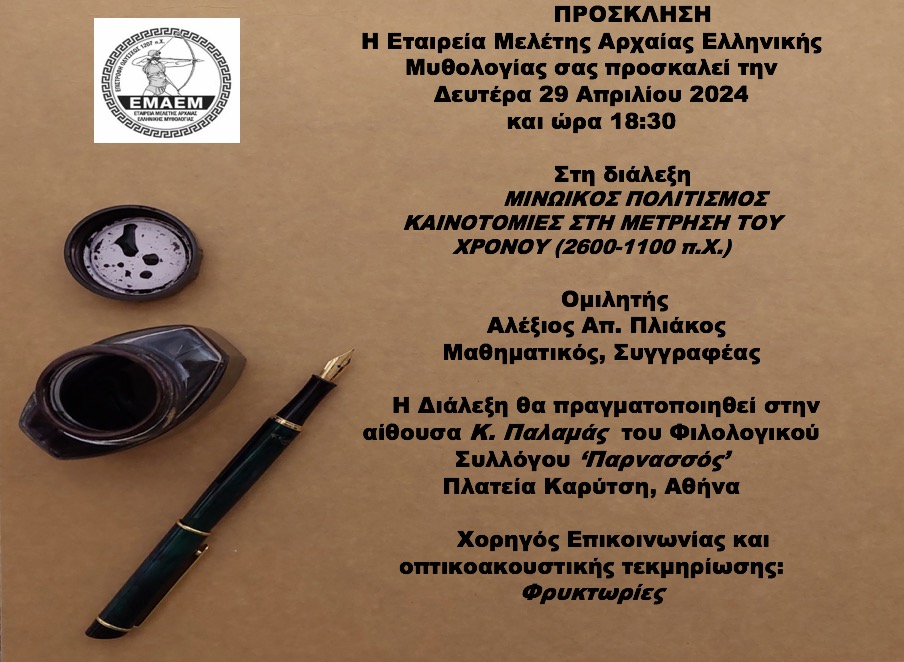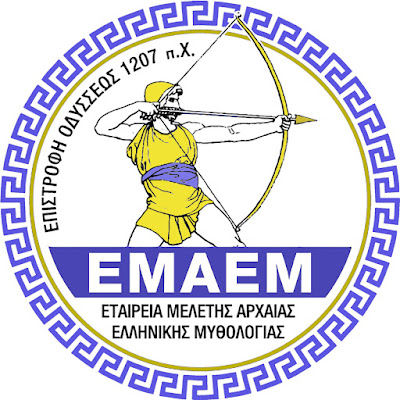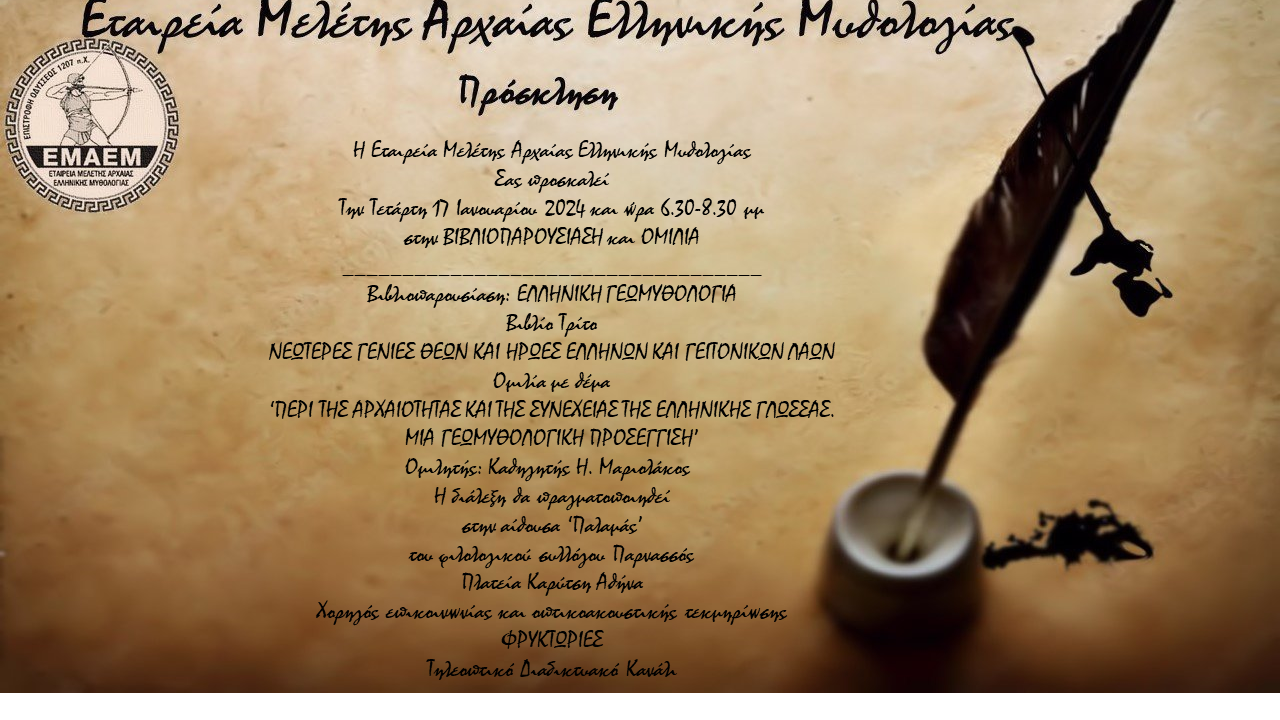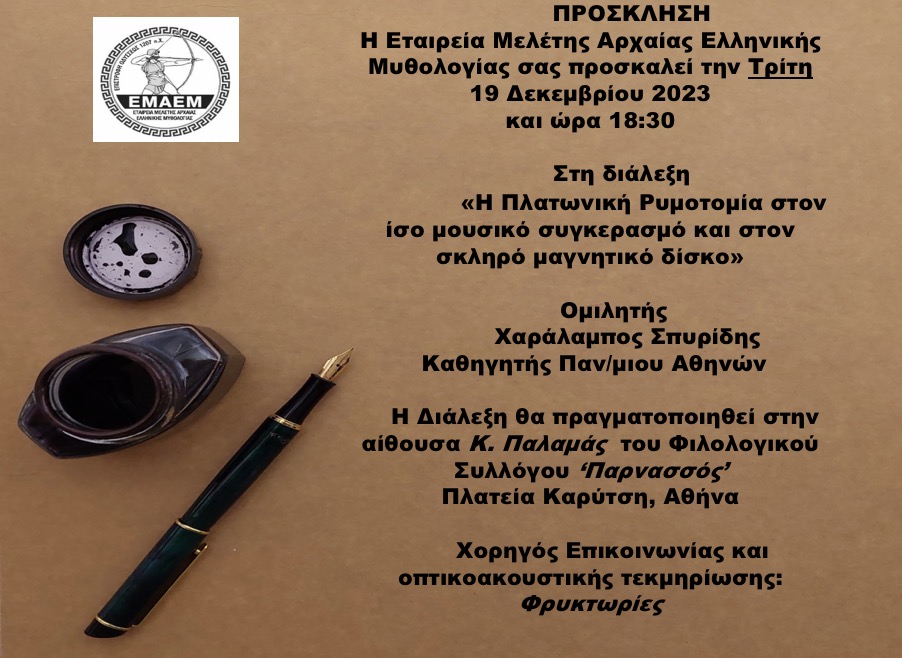ΒΙΒΛΙΟΠΑΡΟΥΣΙΑΣΗ ΚΑΙ ΟΜΙΛΙΑ
Τετάρτη 17 Ιανουαρίου 2024, 6.30-8.30 μμ
Literary Society "Parnassos"
(Αίθουσα ‘Παλαμάς’),
Karytsi Square, Athens
ΒΙΒΛΙΟΠΑΡΟΥΣΙΑΣΗ
Στα πλαίσια των εκδηλώσεων της ΕΜΑΕΜ, θα παρουσιαστεί το βιβλίο του Καθηγητή Η. Μαριολάκου
ΕΛΛΗΝΙΚΗ ΓΕΩΜΥΘΟΛΟΓΙΑ
Βιβλίο Τρίτο
ΝΕΩΤΕΡΕΣ ΓΕΝΙΕΣ ΘΕΩΝ ΚΑΙ ΗΡΩΕΣ ΕΛΛΗΝΩΝ ΚΑΙ ΓΕΙΤΟΝΙΚΩΝ ΛΑΩΝ
Εκτός από τον συγγραφέα, θα προλογίσουν οι κ.κ. Καθηγητές:
Σ. Πριόβολου, Ομότιμη Καθηγήτρια της Φιλοσοφικής Σχολής του Πανεπιστημίου Αθηνών και πρόεδρος του Σώματος Ομότιμων Καθηγητών ΕΚΠΑ.
Ε. Λέκκας, Καθηγητής του τμήματος Γεωλογίας και Γεωπεριβάλλοντος του Εθνικού και Καποδιστριακού Πανεπιστημίου Αθηνών και Πρόεδρος του Οργανισμού Αντισεισμικού Σχεδιασμού και Προστασίας (ΟΑΣΠ).
Σ. Παπαμαρινόπουλος, Καθηγητής Γεωφυσικής του Πανεπιστημίου Πατρών και Πρόεδρος της ΕΜΑΕΜ.
Περίληψη Ομιλίας της Καθηγήτριας κ. Σ. Πριόβολου
ΕΛΛΗΝΙΚΗ ΓΕΩΜΥΘΟΛΟΓΙΑ ΟΜ.ΚΑΘΗΓΗΤΗ ΗΛΙΑ ΜΑΡΙΟΛΑΚΟΥ
Όλοι σχεδόν έχουν αποδεχθεί ότι η ελληνική μυθολογία είναι ένα γοητευτικό παραμύθι, που δεν έχει καμία απολύτως σχέση με την προϊστορική πραγματικότητα.
Από την έρευνα του ομ.καθηγητή Ηλία Μαριολάκου, στους τρεις τόμους της Ελληνικής Γεωμυθολογίας, προκύπτει ότι στην ελληνική Μυθολογία υπάρχει μοναδική σύμπτωση μεταξύ της φυσικογεωλογικής εξέλιξης μιας περιοχής και εκείνης της ανθρώπινης κοινωνίας, όπως συμβαίνει μεταξύ της φυσικογεωλογικής εξέλιξης του Αιγιακού και του ευρύτερου Περιαιγιακού χώρου, και της εξέλιξης στο Γενεαλογικό Δένδρο των Θεών και των Θεοτήτων, όπως τις περιγράφει στη Θεογονία του ο Ησίοδος.
ΣτονIτόμο αναδύονται συνοπτικά η φυσικογεωγραφική εξέλιξη του ευρύτερου αιγαιακού χώρου , καθώς και ορισμένες από τις πρώτες τεχνολογικές δραστηριότητες των προϊστορικών κατοίκων του. Ο IIτόμος της Γεωμυθολογίαςείναι αποκαλυπτικός για να μην πω και ανατρεπτικός, καθώς η έρευνα του Ηλία Μαριολάκου πάνω σε αρχαίους συγγραφείς, και συγκεκριμένα τον Διόδωρο Σικελιώτη – κατακλυσμός της Σαμοθράκης – τον οδηγεί στην εκτίμηση ότι δεν παρατηρείται διακοπή της συνέχειας της ελληνικής γλώσσας εδώ και 12.500 χρόνια τουλάχιστον.Ως φιλόλογος, σταματώ στο σημείο, όπου ο συγγραφέας διερωτάται : «γιατί οι Ινδοευρωπαϊστές αποκλείουν την περίπτωση να έχουν επηρεάσει, και οι Έλληνες, τη γλώσσα των Κελτών και των Γαλατών για παράδειγμα, αλλά πρέπει οπωσδήποτε οι αγνώστου προέλευσης Ινδοευρωπαίοι να έχουν επηρεάσει την Ελληνική;». Εύλογο το ερώτημα και δυστυχώς απάντηση επίσημη δεν υπάρχει, και φοβούμαι ότι …δεν θα υπάρξει! Η διαπίστωση,όμως, του συγγραφέα παραμένει εύλογη και αποκαλυπτική.
Στον IIIτόμο δίνεται απάντηση στα ερωτήματα που σχετίζονται με τη γένεση των θεών, και συγκεκριμένα με το «πότε» και «για ποιους λόγους» δημιουργήθηκαν οι συγκεκριμένες γενεές θεών συνδέοντάς τες με τις καθοριστικής σημασίας κλιματικές μεταβολές και τις συγκλονιστικές επιπτώσεις στη γεωπεριβαλλοντική εξέλιξη του ευρύτερου Αιγαιακού χώρου κατά τα τελευταία 18.000 χρόνια,
Το έργο του Ηλία Μαριολάκουγια την Ελληνική Γεωμυθολογία με τη βαθειά γνώση της επιστήμης του,και όχι μόνο, μοιάζει με μικρό εγκυκλοπαιδικό λεξικό. Είναι πόνημα πολύχρονης και πολύπονης έρευνας, που αναδεικνύει τη σημασία της Γεωμυθολογίας, άγνωστης στο ευρύ κοινό. Πρόκειται για μια αξιόλογη και πρωτότυπη σειρά βιβλίων ενός αξιόλογου και αναγνωρισμένου διεθνώς ερευνητή, που συμβάλλει τα μέγιστα στην Επιστήμη.
Ομ.καθηγήτρια Στέλλα Πριόβολου, πρόεδρος Σώματος Ομοτίμων Καθηγητών ΕΚΠΑ, Κοσμήτωρ Δημοτικού Λαϊκού Πανεπιστημίου Αγ.Παρασκευής
Περίληψη Ομιλίας Ομ. Καθηγητή κ. Η. Μαριολάκου
The third book describes the activities of the gods of the 4th generation, according to Hesiod's pedigree, and their relationship with the geo-environment, starting with the river-gods and the six great gods and the goddesses of Olympus. Next are the gods of the younger generations and finally the various heroes.
Special importance is given to the heroes, forefathers of the Greeks, as well as others less known or completely ignored, such as Palamedes and Aghisis, as well as to many who through of their acti-vities proves to be the decisive contribution of the prehistoric Greeks in the formation of the Ancient Greek civilization first and then of the European and more generally of the West.
An attempt was made in the book to answer the questions relating to the genesis of the gods, namely "when" and "for what reasons" were the particular generations of gods created, linking them to the crucial climatic changes and the shocking effects on the geo-environmental evolution of the wider Aegean area during the last 18,000 years, which is - in its details - unique on the entire planet.
At the same time, reference is also made to the theogony of the various peoples who lived around the Eastern Mediterranean (Sumerians, Babylonians, Hittites, Egyptians, Israelites) and they too developed important cultures mainly during the prehistoric era.
ΟΜΙΛΙΑ
On the antiquity and continuity of the
Greek Language.
A Geomythological approach.
Ilias D. Mariolakos
emer. Professor of Geology N.K.U.A.
Abstract
The general impression, that prevails in the world, is that Greek Mythology, is fantastic stories, a creation of the imaginative ancient Greeks.
The Geomythological research, however, in the last years, has proven, that many myths, are connected to the great climate change, which was observed 18,000 years ago and was continued until 6,000 years ago and mainly with the effects on the geoenvironment of the Aegean and Peri-Aegean area, proves, that many myths are associated with natural phenomena, which the modern Geoscience can date with satisfactory accuracy.
This is the case with the flood of Samothrace, described by Diodorus from Sicily (1st century BC). The latest research on oil, carried out in the sediments of the Black Sea, proved that the flood in question took place between 14,500 and 12,500 BP (Before Present). Because at this time, writing had not yet been invented, the flood in question must have rescued and spread as a "historical event", as an oral tradition. However, the preservation of a tradition, for such a long period of time requires, as a necessary condition, that the younger generations speak the same language as the older ones.
Consequently: The Greek Language must be spoken continuously, from 14,000 BP, until today, without interruption. Therefore, the prevailing opinion, that the Greek Language was brought with them by the Greeks of Indo-European origin, who arrived in Greece around 2,000 BC is not valid.
Mariolakos Ilias – Curriculum Vitae
Ilias Mariolakos is Emeritus Professor of Geology of the National and Kapodestrian University of Athens (E.K.P.A), Dr. of Hydrogeology of the Univ. Erlangen Nürnberg, Germany (1968). He was a scholarship holder of the Deutscher Akademisher Austausch Dienst (DAAD), Huboldt Foundation and Deutsch-Japanisches Zentrum. He has taught as a Visiting Lecturer at the University of New South Wales (Sydney) (1968-1969) and at the Free University of Brussels as a Visiting Professor. He is an Honorary Professor at the University of Salzburg and a Foreign Fellow of the Russian Academy of Natural Sciences.
He founded the Sector of Dynamics, Tectonics and Applied Geology of the Department of Geology of the University of Athens. He was Chairman of the Board of Directors. of the Institute of Geological and Mining Research, (I.G.M.E.), of the Hellenic Geological Society and Coordinator of the Scientific Committee of the Post-Graduate Department of UNESCO for the Quaternary, (Cooperation of the National Kapodestrian University of Athens and Vrije Universiteit Brussel), Vice-President of the National Center for Marine Research (N.C.M.R.) and the Executive Committee of the Regulatory Plan Organization of Athens, as well as the Hellenic Geographical Society and for many years a member of the Central Archaeological Council of Greece.
He has given numerous lectures at many foreign Universities, foreign Geological Services, and other Scientific and Social Agencies, as well as in mass media. In addition to his professional and academic career, he cultivated the research and development of the subject of Geomythology.
He is the author of over two hundred original works and a four-volume work on Geomythology.










